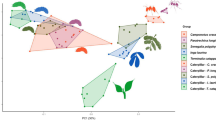Summary
The searching efficiencies of a primary parasite (Diaeretiella rapae (McIntosh)) and a hyperparasite (Alloxysta brassicae (Ash.)) were investigated and compared. In both species, at all parasite densities, there was a curvilinear relationship (P<0.001) between the number of hosts parasitised and the host density. A linear regression (loga=logQ−m logP) was fitted for log area of discovery against log parasite density (P<0.001). The area of discovery for its immediate (i.e. primary) host (viz.Diaeretiella for the hyperparasite and aphid forDiaeretiella) is lower in the hyperparasite than in the primary parasite. InDiaeretialla both the searching efficiency and the mutual interference constant increased (but not significantly,P>0.05) in the presence of its males.
Similar content being viewed by others
References
Cheke, R. A. (1974) Experiments on the effect of host spatial distribution on the numerical responses of parasitoids.J. Anim. Ecol.43: 107–114.
Chua, T. H. (1975)Population studies of the cabbage aphid, Brevicoryne brassicae (L.),and its parasites, with special reference to synchronisation. Ph.D. thesis, University of London.
Chua, T. H. (1977) Population studies ofBrevicoryne brassicae (L.), its parasites and hyperparasites in England,Res. Popul. Ecol.19: 125–139.
Chua, T. H. (1978) Pattern and influencing factors of emergence inDiaeretiella rapae and its parasites.Z. Angew. Ent.85: 436–442.
Hafez, M. (1961) Seasonal fluctuations of population density of the cabbage aphid,Brevicoryne brassicae (L.) in the Netherlands, and the role of its parasites,Aphidius (Diaretiella) rapae (Curtis).Tijdschr. Plziekt.67: 445–548.
Hassell, M. P. (1971) Mutual interference between searching insect parasites.J. Anim. Ecol.40: 473–486.
Hassell, M. P. andG. C. Varley (1969) New inductive population model for insect parasites and its bearing on biological control.Nature, Lond.223: 1133–1137.
Holling, C. S. (1959) Some characteristics of simple types of predation and parasitism.Can. Ent.91: 385–298.
Kfir, R., H. Poddler andD. Rosen (1975) Presence of males increase the area of discovery of a gregarious parasitoid.Ann. ent. Soc. Am.68: 707–709.
Kfir, R., H. Poddler andD. Rosen (1976) The area of discovery and searching strategy of a primary parasite and two hyperparasites.Ecological Entomology1: 287–295.
Nicholson, A. J. (1933) The balance of animal population.J. Anim. Ecol.2: 131–178.
Nicholson, A. J. andA. V. Bailey (1935) The balance of animal populations. Part I.Proc. Zool. Soc. Lond., 551–598.
Rogers, D. J. andM. P. Hassell (1974) A model for avoidance of super-parasitism by solitary insect parasitoids.J. Anim. Ecol.44: 623–638.
Sedlag, U. (1964) Zur Biologie und Bedentung vonDiaeretiella rapae (McIntosh) also Parasit der kohlblattlaus (Brevicoryne brassicae L.).Nachr. Bl. d. Pflsch Dienst., Stuttg18: 81–86.
Stinner, R. E. andH. L. Lucas, Jr. (1976) Effects of contagious distributions of parasitoid eggs per host and of sampling vagaries on Nicholson's area of discovery.Res. Popul. Ecol.18: 74–88.
Thompson, W. R. (1924) La theorie mathematique de l'action des parasites entomophages et le facteur du hasard.Annls. Fac. Sci. Marseille2: 69–89.
Watt, K. E. F. (1959) A mathematical model for the effect of densities of attacked and attacking species on the number attacked.Can. Ent.91: 129–144.
Author information
Authors and Affiliations
Rights and permissions
About this article
Cite this article
Chua, T.H. A comparative study of the searching efficiencies of a parasite and a hyperparasite. Res Popul Ecol 20, 179–187 (1979). https://doi.org/10.1007/BF02512623
Issue Date:
DOI: https://doi.org/10.1007/BF02512623




